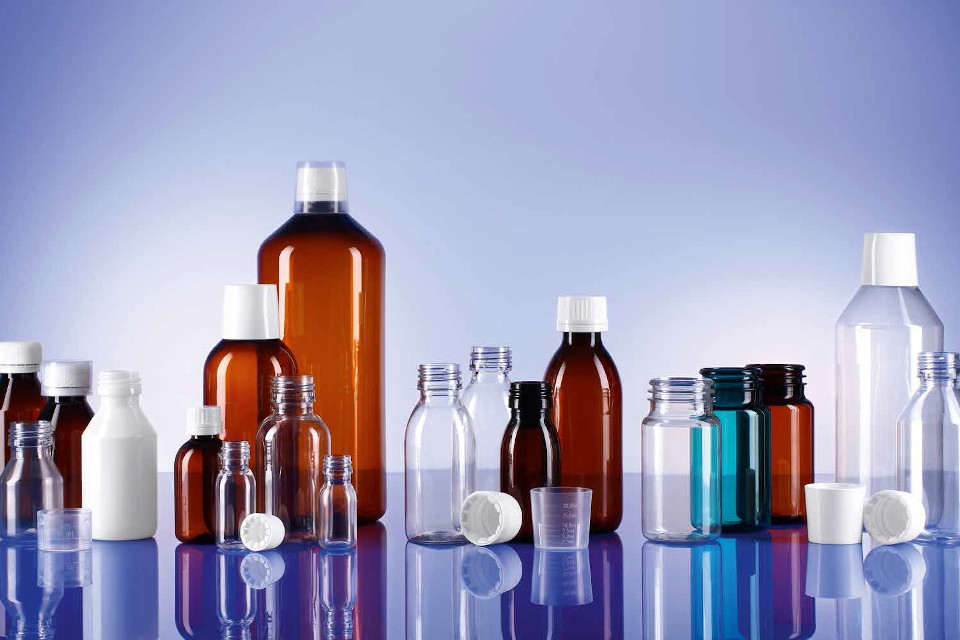The projected surge in the net worth of pharmaceutical plastic bottles’ market share is substantial, set to escalate from US$ 35.8 billion in 2023 to surpassing US$ 97.1 billion by 2033. This robust growth trajectory is poised to propel market expansion, with a forecasted Compound Annual Growth Rate (CAGR) of 10.5% from 2023 to 2033. The pharmaceutical plastic bottles sector is anticipated to witness a significant uptick, driven by factors such as increasing pharmaceutical production and the demand for secure and compliant packaging solutions, reflecting the pivotal role these bottles play in the pharmaceutical packaging landscape.
The pharmaceutical industry extensively relies on pharmaceutical plastic bottles for packaging both solid and liquid formulations, and the years ahead are poised to see a substantial uptick in demand, driven by the global expansion of healthcare infrastructure.
Experiencing a noteworthy surge in demand, the United Kingdom anticipates an impressive Compound Annual Growth Rate (CAGR) of around 8.2% for pharmaceutical plastic bottles over the forecast period. This robust growth is rooted in the UK’s well-established and advanced healthcare system, reflective of sustained government initiatives to fortify the healthcare sector.
Request Sample: https://www.futuremarketinsights.com/reports/sample/rep-gb-7750
In the pharmaceutical industry, plastic packaging is in high demand because of its unmatched capabilities. Moreover, additional features led to increased adoption in pharma, including moisture resistance, high dimensional stability, high impact strength, resistance to strain, low water absorption, transparency, and heat and flame resistance.
Pharmaceutical manufacturers are increasingly replacing glass bottles with pharmaceutical plastic bottles. Since they offer the same benefits and do not break as easily as glass bottles. In addition to being more economical than glass bottles, Pharma plastic bottles are also easier to procure. This makes shipping and transit of pharmaceutical plastic bottles hassle-free, thus propelling the market trend. Pharmaceutical plastic bottles are also light and less bulky.
In the pharmaceutical and healthcare industries, plastic bottles have become increasingly popular due to the convenience they offer in the delivery of liquid medicines and their ease of use. Moreover, pharmaceutical plastic bottles are lighter and less prone to breaking than metal bottles.
Key Takeaways from the Pharmaceutical Plastic Bottles Market
- According to bottle type, plastic bottles for ophthalmic/nasal formulations have contributed the most to growth. The segment will account for 42.7% of sales in 2023.
- A valuation of US$ 9.2 Billion is expected in 2023 for the polyethylene terephthalate (PET) segment anticipated to increase at a CAGR of 4%.
- The demand for pharmaceutical plastic bottles in the U.K. is expected to rise at nearly 2% CAGR.
- The market in China is estimated to grow at a CAGR of 4%during the forecast period.
“Due to increasing sustainability concerns and a reduction in the pharmaceutical industry’s environmental impact, the market for pharmaceutical plastic bottles is growing. Advancements in technology and the use of plastic bottles for solid and liquid oral medicines have contributed to the growth of the pharmaceutical plastic bottle industry.“ says an FMI analyst.
Competition Landscape in the Pharmaceutical Plastic Bottles Market
The pharmaceutical plastic bottle market is fragmented with the presence of many players like Amcor Limited, Aptar Pharma, Berry Plastics Group, Inc., Graham Packaging Company, Alpha Packaging, and Alpack Plastic Packaging. For dominating the market, the players use organic and inorganic strategies, including mergers & acquisitions, partnerships, product launches, and collaborations.
Request Report Methodology: https://www.futuremarketinsights.com/request-report-methodology/rep-gb-7750
The Major Key Players Are:
- Gerresheimer AG,
- AptarGroup, Inc.,
- O. Berk Company, LLC,
- Alpha Packaging Holdings, Inc.,
- Comar, LLC,
- Bormioli Pharma S.p.a.,
- C.L.Smith Company,
- United States Plastic Corporation,
- Weener Plastics Group BV
are some of the key players in the pharmaceutical plastic bottles market.
Recent Developments in the Pharmaceutical Plastic Bottles Market
- It was announced in December 2021 that the Comar Group had acquired Omega Packaging, an injection molding, and blow molding company. Comar’s strategy to provide healthcare customers with end-to-end custom manufacturing solutions and a broad product range is enhanced with Omega Packaging’s child-resistant (CR) closures and precision mold-building capabilities.
- In September 2021, Pretium Packaging, a portfolio company of Clearlake Capital Group, acquired Alpha Packaging from Irving Place Capital for an undisclosed sum. By combining Alpha Packaging and Pretium Packaging, the combined company will be able to provide advanced packaging services to both existing and prospective customers alike.
- It was announced in March 2021 that Gerresheimer AG, a leading manufacturer of pharmaceutical plastic bottles, was building and developing a new manufacturing facility in Ohio, USA. Plastic bottles for solid, liquid, and ophthalmic/nasal formulations will also be produced at this facility.
- In January 2021, ALPLA Werke Alwin Lehner GmbH & Co KG announced it would invest more than five million dollars in an extrusion system to manufacture recycled PET in Italy.
- It was announced in July 2019 that Berry Global had completed its acquisition of RPC Group. This created one of the largest plastic packaging companies in the world with over 290 locations worldwide.
Market Drivers:
- Rising Pharmaceutical Industry: The growth of the pharmaceutical sector is a significant driver for the demand for packaging materials, including plastic bottles. As the pharmaceutical industry expands, so does the need for packaging solutions that ensure product safety and compliance.
- Advantages of Plastic Packaging: Plastic bottles offer several advantages, such as being lightweight, durable, and cost-effective. These factors contribute to their popularity in the pharmaceutical industry. Additionally, plastic bottles can be designed to be tamper-evident, helping to maintain the integrity of the packaged products.
- Innovations in Packaging Technology: Ongoing advancements in packaging technology, such as the development of smart packaging and anti-counterfeiting measures, can drive the adoption of plastic bottles in the pharmaceutical sector.
- Regulatory Compliance: Stringent regulations regarding the packaging and transportation of pharmaceutical products can drive the demand for high-quality and compliant packaging materials, including plastic bottles.
- Increased Focus on Patient Safety: Patient safety is a top priority in the pharmaceutical industry. Packaging materials play a crucial role in ensuring the safety and efficacy of drugs, and pharmaceutical plastic bottles can be designed to meet these requirements.
Market Restraints:
- Environmental Concerns: The environmental impact of plastic packaging, including issues related to recycling and plastic waste, is a growing concern. This has led to increased scrutiny and calls for more sustainable packaging alternatives, which could impact the demand for traditional plastic bottles.
- Shift towards Alternative Materials: The pharmaceutical industry may explore and adopt alternative packaging materials, such as glass or bio-based plastics, in response to environmental concerns and the need for more sustainable options.
- Cost of Compliance: Meeting regulatory standards and ensuring compliance with pharmaceutical packaging regulations can be costly. This may pose a challenge for some companies, particularly smaller ones, and impact the overall market.
- Perception of Plastic in Pharmaceuticals: There is a growing awareness and preference for certain types of packaging materials among consumers. Some consumers may prefer packaging materials perceived as more environmentally friendly, potentially impacting the market for plastic bottles.
Buy Now/Purchase: https://www.futuremarketinsights.com/checkout/7750
Pharmaceutical Plastic Bottles Market Segmentation by Category
By Bottle Type:
- Plastic Bottles for Solid Formulation
- Plastic Bottles for Liquid
- Plastic Bottles for Ophthalmic/Nasal Formulation
By Material Type:
- Polyethylene (PE)
- High-density polyethylene (HDPE)
- Low-density polyethylene (LDPE)
- Polyethylene terephthalate (PET)
- Polypropylene (PP)
- Polyvinyl chloride (PVC)
By Capacity:
- Below 100 ml
- 100 ml – 250 ml
- Above 250 ml
By Region:
- North America
- Latin America
- Europe
- The Middle East and Africa
- East Asia
About Future Market Insights (FMI)
Future Market Insights, Inc. (ESOMAR certified, recipient of the Stevie Award, and a member of the Greater New York Chamber of Commerce) offers profound insights into the driving factors that are boosting demand in the market. FMI stands as the leading global provider of market intelligence, advisory services, consulting, and events for the Packaging, Food and Beverage, Consumer, Technology, Healthcare, Industrial, and Chemicals markets. With a vast team of over 5000 analysts worldwide, FMI provides global, regional, and local expertise on diverse domains and industry trends across more than 110 countries.
Contact Us:
Future Market Insights Inc.
Christiana Corporate, 200 Continental Drive,
Suite 401, Newark, Delaware – 19713, USA
T: +1-845-579-5705
For Sales Enquiries: sales@futuremarketinsights.com
Website: https://www.futuremarketinsights.com
LinkedIn| Twitter| Blogs | YouTube


